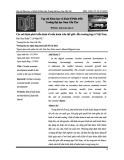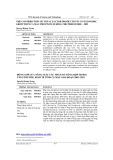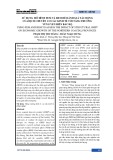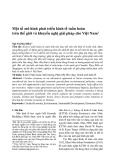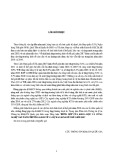
TNU Journal of Science and Technology
229(03): 82 - 88
http://jst.tnu.edu.vn 82 Email: jst@tnu.edu.vn
FACTORS AFFECTING ECONOMIC GROWTH
OF THE SOUTHWEST KEY ECONOMIC REGION
Nguyen Hoang Trung1,2*, Nguyen Chi Hai1
1University of Economics and Law, Viet Nam National University Ho Chi Minh City
2Dong Thap University
ARTICLE INFO
ABSTRACT
Received:
23/10/2023
This study seeks to comprehend the influencing factors on the
economic growth of the pivotal economic region in the Southwest. The
authors conducted research based on the dataset from four provinces
and cities in the region during the period 2005-2022, employing panel
data estimation methods such as OLS pooled regression, fixed effects
(FEM), and random effects (REM). REM was identified as the most
optimal after rigorous testing and comparison of these models. The
research results indicate that, among the six factors analyzed, which
include Labor, Investment Capital, Public Expenditure, Education,
Foreign Direct Investment, and Unemployment Rate, only Public
Expenditure and Foreign Direct Investment have an impact on the
economic growth of the region. These outcomes serve as the
foundational basis for provinces and cities within the key economic
areas to concentrate on enhancing policies related to the utilization of
investment capital, fostering international trade, attracting foreign direct
investment, and elevating workforce quality.
Revised:
10/11/2023
Published:
10/11/2023
KEYWORDS
Economic growth
Southwest key economic region
Panel data regression
Foreign direct investment
Public spending
CÁC YẾU TỐ ẢNH HƯỚNG ĐẾN TĂNG TRƯỞNG KINH TẾ
VÙNG KINH TẾ TRỌNG ĐIỂM TÂY NAM BỘ
Nguyễn Hoàng Trung1,2*, Nguyễn Chí Hải1
1Trường Đại học Kinh tế - Luật, Đại học Quốc gia TP Hồ Chí Minh
2Trường Đại học Đồng Tháp
THÔNG TIN BÀI BÁO
TÓM TẮT
Ngày nhận bài:
23/10/2023
Nghiên cứu này hướng đến việc tìm hiểu các yếu tố tác động đến tăng
trưởng kinh tế của vùng kinh tế trọng điểm Tây Nam Bộ. Nhóm tác giả
nghiên cứu dựa trên bộ dữ liệu của 04 tỉnh, thành phố thuộc vùng trong
giai đoạn 2005 - 2022, thông qua các phương pháp ước lượng dữ liệu
bảng như hồi quy gộp OLS, tác động cố định (FEM), tác động ngẫu
nhiên (REM). Sau khi tiến hành kiểm định và so sánh các mô hình này,
REM được đánh giá là tối ưu nhất. Kết quả nghiên cứu cho thấy trong
6 yếu tố đưa vào phân tích bao gồm Lao động, Vốn đầu tư, Chi tiêu
công, Giáo dục, Đầu tư trực tiếp nước ngoài và Tỷ lệ thất nghiệp, chỉ
có chi tiêu công và đầu tư trực tiếp nước ngoài có tác động đến tăng
trưởng kinh tế của vùng. Phát hiện này là cơ sở cho các tỉnh, thành
thuộc vùng kinh tế trọng điểm tập trung cải thiện các chính sách liên
quan đến sử dụng vốn đầu tư, thương mại quốc tế và thu hút đầu tư
trực tiếp nước ngoài; nâng cao chất lượng lao động.
Ngày hoàn thiện:
10/11/2023
Ngày đăng:
10/11/2023
TỪ KHÓA
Tăng trưởng kinh tế
Vùng Kinh tế trọng điểm Tây
Nam Bộ
Hồi quy dữ liệu bảng
Đầu tư trực tiếp nước ngoài
Chi tiêu công
DOI: https://doi.org/10.34238/tnu-jst.9019
* Corresponding author. Email: nhtrung@dthu.edu.vn

TNU Journal of Science and Technology
229(03): 82 - 88
http://jst.tnu.edu.vn 83 Email: jst@tnu.edu.vn
1. Introduction
Economic growth was the expansion of a country's Gross Domestic Product (GDP) or
potential output. In other words, economic growth occurred when a country's production
possibilities frontier (PPF) shifted outward [1]. Therefore, economic growth is considered the
GDP or gross national product (GNP) increase over a certain period. Theories of economic
growth provide diverse perspectives on how the economy develops over time. The role of capital
accumulation is considered very important for economic growth [2]. Besides, human factors also
contribute to economic growth [3]. On the other hand, besides capital and human factors,
economic growth also depends on investment in research and development [4].
Economic growth is affected by many factors. Within the article's research scope, we focus on
analyzing factors such as investment capital, labor, education, foreign direct investment, public
spending, and the unemployment rate on Vietnam's economic growth—the critical economic region
of the Southwest region. Around the world, the impact of these factors on economic growth has
been verified through many studies by many authors. Foreign Direct Investment (FDI) can benefit
the receiving industry and other domestic industries through the spillover effects of improved
human capital and technology [5]. However, for the receiving country, FDI can also bring negative
impacts. Foreign companies often only invest in areas they consider adequate, potentially leading to
competition with domestic businesses and reducing the country's overall benefits [6].
Educational attainment is gradually becoming a critical factor in economic development, widely
recognized as a clear indicator of a country's economic strength. The country's economic growth
rate has been demonstrated to be increased by 0.7% per year for each additional year of schooling
[7]. This highlights that investing in human capital is more than simply improving educational
attainment; it is an essential means of enhancing workforce employability and improving
productivity. Furthermore, it emphasizes the academic level of workers as a critical measure of
human capital directly related to labor performance and productivity in an economic context [8].
Public spending positively and significantly impacts economic growth [9]. Similar to that
conclusion, research from 14 countries in the European Union shows that infrastructure and
human capital play an important role, having a clear impact on long-term economic growth [10 ].
Examining the link between unemployment and the economic landscape in South Africa
between 1994 and 2012 reveals fascinating and insightful insights. Using the cointegration method
established a long-run association between the variables, indicating a positive correlation between
GDP and unemployment in South Africa [11]. Taking this line of research a step further, the study
uses the OLS method and shows a 'paradoxical' relationship between growth and employment [12].
In practical terms, the Southwest Key Economic Region was officially designated by the
Government of Vietnam on April 16, 2009, including four provinces and cities: Can Tho, An Giang,
Kien Giang, and Ca Mau, located in the Mekong Delta region. Despite favorable natural conditions,
economic growth in the Southwest Key Economic Region still needs to meet available resources.
Compared to the remaining three key economic regions, the Northern critical economic region, the
Southern key economic region, and the Central critical economic area, the Southwest key economic
region has the slowest growth rate. In 2017 - 2021, the Northern Key Economic Region stood out
with the fastest Gross Regional Domestic Product (GRDP) growth rate, reaching an average annual
rate of approximately 7.96%. Following closely, the Southern Key Economic Region recorded the
second-highest GRDP growth rate, reaching about 4.2%/year. The Central Key Economic Region
has a GRDP growth rate of about 4.1%/year in third place. Meanwhile, the GRDP growth of the
Mekong Delta Key Economic Region over the past five years has been at 3.8% annually [13].
Until now, there has not been a complete study on the factors affecting economic growth in
the Southwest critical economic region. Previous studies mainly analyzed one locality in the
critical economic region of the Southwest. They approached the analysis of TFP's contribution to
economic growth, for example, analyzing growth for Kien Giang province [14] and similarly for
Can Tho City [15]. Some studies cover the entire Mekong Delta region, such as studying the

TNU Journal of Science and Technology
229(03): 82 - 88
http://jst.tnu.edu.vn 84 Email: jst@tnu.edu.vn
impact of human capital on the economic growth of the Mekong Delta [16]. Stemming from the
general research as well as the practical urgency of the issue of factors affecting economic
growth in the crucial economic region of the Southwest, it shows that there is a need for an
exploratory study to clear the problem. Therefore, this study aims to clarify the influence of
different factors on the economic growth of the Southwest Key Economic Region. The research
results serve as a reference for policy recommendations to promote economic development in the
Southwest Key Economic Region and the Mekong Delta region.
2. Data and Methodology
2.1. Data
The article relies on secondary data obtained from the General Statistics Office and local
statistical offices within the Southwestern Key Economic Region, spanning the years from 2005
to 2022. To ensure consistency, all data collected has been adjusted to a common reference year
of 2010. The research sample encompasses a total of 72 observations, spanning four provinces
and an 18-year timeframe.
2.2. Method of analysis
A panel data regression model is employed, utilizing techniques such as Pooled OLS, Fixed
Effects Model (FEM), and Random Effects Model (REM), to assess the collective influence of
independent variables on the dependent variable (LnGDRP). The choice of which model to
analyze depends on the conducted tests. Selecting between OLS, REM, and FEM models relies
on the results of the Lagrange Breusch-Pagan coefficient test. If the p-value is less than 5%, the
OLS model should be discarded. To decide between REM and FEM models, the Hausman Test is
employed, and if the p-value is less than 5%, the REM model is chosen.
The structure of the research model is as follows:
Where:
"i" encompasses the four provinces/cities within the Southwestern Key Economic Region.
"t" represents the data spanning from 2005 to 2022.
The model's variables are outlined in Table 1.
Table 1. Variables' Measurement in the Model
Variable
Definition of variables
Source of Data
Dependent variable
Economic growth (LnGRDP)
The GRDP of the four provinces is computed in
logarithmic form at 2010 prices, measured in billion VND.
[17]; [18]
Independent variables
Investment capital (K)
This encompasses investment capital for capital
construction, capital for acquiring fixed assets excluding
capital construction, and investment capital for renovating
and enhancing fixed assets, all measured in billion VND
and presented in logarithmic form.
[2]; [4]
Labor (L)
The labor force, consisting of individuals aged 15 years
and older, is expressed in logarithmic form.
[2]; [4]
Education (Edu)
Percentage of high school students relative to the entire
local population (%).
[7]; [8]
Unemployment rate (Ur)
Local unemployment rate (%)
[19]; [12]
Public spending (PS)
Local budget expenditures (in billion VND) presented in
logarithmic form.
[9]
Foreign Direct Investment (FDI)
Amount of realized foreign direct investment (in millions
of dollars).
[20]
(Source: Compiled by the authors)

TNU Journal of Science and Technology
229(03): 82 - 88
http://jst.tnu.edu.vn 85 Email: jst@tnu.edu.vn
3. Results and Discussion
3.1. Research results
3.1.1. Description of variables in the research sample
The outcomes presented in Table 2 delineate the variables under analysis in the research
model. The total product within the research area, represented by Gross Regional Domestic
Product (GRDP), possesses an average value of 41,131.4 billion VND. The lowest recorded
figure is in Ca Mau (7673 billion VND in 2005), while the highest is in Kien Giang (7215.4
billion VND in 2015). Regarding investment capital, the average stands at 13,173.2 billion VND.
Kien Giang registered the lowest investment capital in 2005, with 2,261.8 billion VND and the
highest in 2018, at 33,572.2 billion VND. The average labor force (L) in the region amounts to
858,025.8 people, with the lowest figure observed in Ca Mau in 2005 (581,600 people) and the
highest in An Giang in 2011 (1,271,100 people). The average ratio of high school students to the
total population (Edu) is 2.3%, with Can Tho recording the lowest percentage in 2018 (1.5%) and
An Giang achieving the highest in 2022 (3.1%). In the working-age group, the average
unemployment rate (Ur) is 3.5%, with Ca Mau displaying the lowest rate in 2022 (1.4%) and Can
Tho registering the highest in 2005 (7.4%). Public expenditure (PS) averages 1,191.2 billion
VND, with Ca Mau reporting the lowest value in 2005 (1,515.5 billion VND) and Kien Giang
recording the highest in 2019 (30,874.2 billion VND). The average Foreign Direct Investment
(FDI) amounts to 16.2 million USD. The lowest FDI, denoted as 0 million USD, is observed for
2005 and 2006, as it's solely calculated based on actual realized capital during those years. The
highest FDI was recorded for Kien Giang in 2009, at 441 million USD.
Table 2. Description of Variables Analyzed
Variable
Observations
Mean
Standard deviation
Min
Max
GRDP (billion VND)
72
41131,4
15980,9
7673
72151,4
K (billion VND)
72
13173,2
7834,7
2261,8
33572,2
L (person)
72
858025,8
214004,7
581600
1271100
Edu (%)
72
2,3
0,3
1,5
3,1
Ur (%)
72
3,5
1,3
1,4
7,4
PS (billion VND)
72
11991,2
8743,6
1515,5
30874,2
FDI (million USD)
72
16,2
53,3
0
441
(Source: calculations by the authors)
3.1.2. Correlation analysis
Table 3 displays the correlation between the independent variables in the research model
based on the results. Notably, all the correlation coefficients exhibit values below 0.7, indicating
the absence of multicollinearity within the model. However, this conclusion will be subject to
further examination in the section that test the regression model's assumptions.
Table 3. Correlation matrix of variables in the model
LnK
LnL
Edu
Ur
LnPS
FDI
LnK
1.00
LnL
-0.27
1.00
Edu
-0.09
-0.27
1.00
Ur
-0.25
-0.35
0.08
1.00
LnPS
0.65
0.24
0.11
-0.58
1.00
FDI
-0.08
-0.03
0.03
0.10
-0.09
1.00
(Source: calculations by the authors)
3.1.3. Regression results
The analysis results presented in Table 4, using Stata software, demonstrate that none of the
three models (OLS, REM, and FEM) exhibit multicollinearity or serial correlation issues. To

TNU Journal of Science and Technology
229(03): 82 - 88
http://jst.tnu.edu.vn 86 Email: jst@tnu.edu.vn
discern the preferred model among OLS, REM, and FEM, the Breusch–Pagan Lagrange multiplier
test is employed. The results indicate a remarkably low p-value of 0.0000, which falls significantly
below the predetermined levels of statistical significance. Consequently, the OLS model is deemed
less suitable than the other two. The Hausman test yields a probability (Prob > chi2) greater than
0.05, which exceeds the standard significance levels. As a result, the null hypothesis (Ho) cannot be
rejected. Consequently, the Fixed Effects Model (FEM) is unsuitable, and the Random Effects
Model (REM) should be employed instead. A heteroskedasticity test will be performed to ascertain
the presence of this issue in any of the models. The examination reveals that the FEM model
violates the assumption of homoskedasticity, while the REM model remains unaffected. Thus, the
REM model emerges as the most suitable choice after satisfying the tests for regression model
assumptions. Consequently, the analysis results will be based on the REM model.
Table 4. Regression Results for OLS, REM, and FEM Models
Model
OLS
REM
FEM
LnK
-0.053
(-0.58)
-0.053
(-0.58)
-0.141**
(-2.11)
LnL
0.249
(1.19)
0.249
(1.19)
1.302***
(3.10)
Edu
-0.042
(-0.29)
-0.041
(-0.29)
0.024*
(1.94)
Ur
0.014
(0.45)
0.014
(0.45)
-0.044
(-1.64)
LnPS
0.525***
(6.36)
0.525***
(6.36)
0.485***
(7.61)
FDI
0.001*
(1,81)
0.001*
(1.81)
0.0004
(1.13)
Constant
2.884
(0.89)
2.884
(0.89)
-10.64*
(-1.78)
N= 72
F(6,65) = 28.37
Prob > F = 0.000
R2 = 0.723
N= 72
R2:
Within = 0.75
Between = 0.70
Overall = 0.72
Wald chi2(6) =
170.20
Prob > chi2 = 0.000
N= 72
R2:
Within = 0.82
Between = 0.38
Overall = 0.55
F(6,62) = 47.74
Prob > F = 0.000
Multicollinearity test
Mean ViF = 2.5
Test for serial correlation
F (1, 3) = 0.854
Prob > F = 0.423
Test for heteroskedasticity
Chi 2(27) = 49.63
Pro > chi2 = 0.005
Chibar2(01) = 0.00
Prob > chibar2 = 1.00
Chi 2(4) = 185.00
Prob > chi2 = 0.000
* p < 0.1, ** p < 0.05, *** p < 0.01; t value in parentheses
(Source: Results Estimated Using Stata Software)
3.2. Discussion
The regression analysis results, employing the REM estimation method displayed in Table 4,
reveal a p-value of 0.000, less than 0.05. So, the regression model is statistically significant,
indicating that at least one independent variable in the model affects the dependent variable,
LnGRDP. The substantial R2 coefficient of 75.00% means that the variables incorporated into
the model account for 75.00% of the variation in LnGRDP, elucidating the factors considered in
the model. The remaining unexplained variation can be attributed to other unexplored factors.
Assessing the significance level of each variable within the model, it is evident that two
variables impact the economic growth of provinces and cities within the critical economic region
of the Southwest: LnPS and FDI. The remaining variables, including investment capital,

